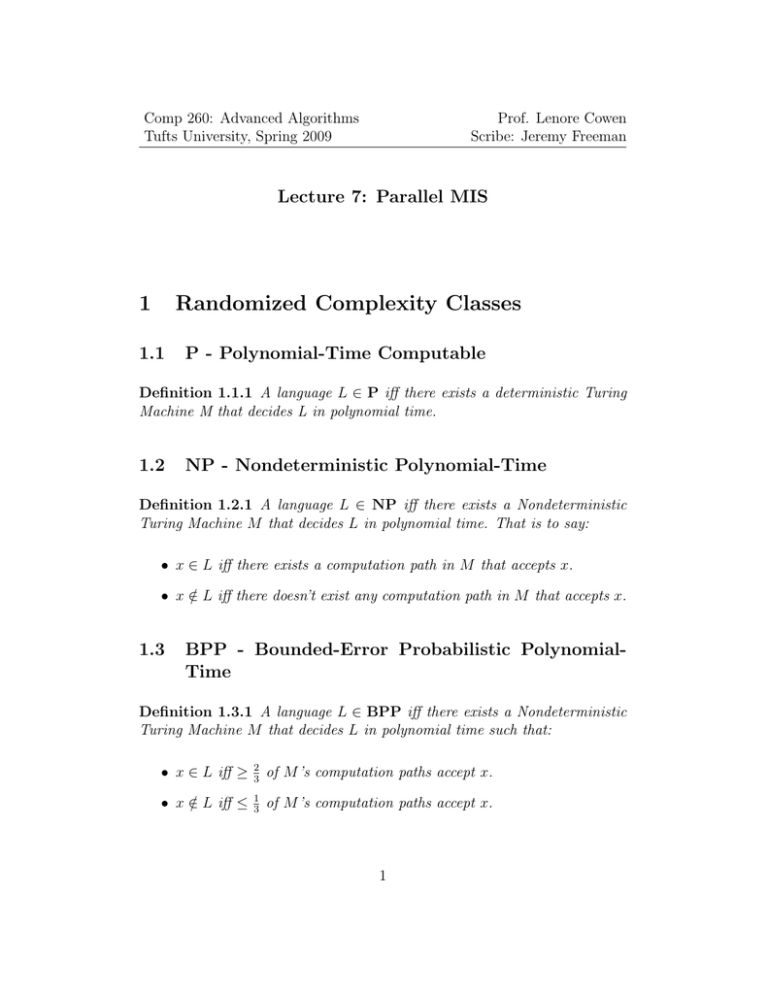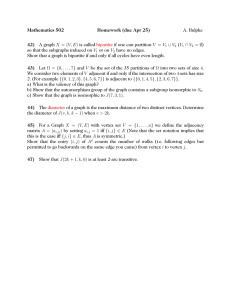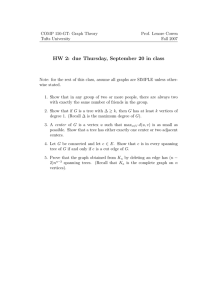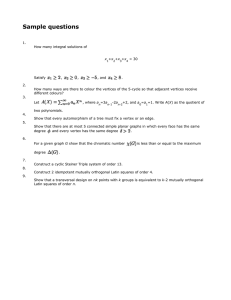1 Randomized Complexity Classes Lecture 7: Parallel MIS 1.1
advertisement

Comp 260: Advanced Algorithms
Tufts University, Spring 2009
Prof. Lenore Cowen
Scribe: Jeremy Freeman
Lecture 7: Parallel MIS
1
Randomized Complexity Classes
1.1
P - Polynomial-Time Computable
Definition 1.1.1 A language L ∈ P iff there exists a deterministic Turing
Machine M that decides L in polynomial time.
1.2
NP - Nondeterministic Polynomial-Time
Definition 1.2.1 A language L ∈ NP iff there exists a Nondeterministic
Turing Machine M that decides L in polynomial time. That is to say:
• x ∈ L iff there exists a computation path in M that accepts x.
• x∈
/ L iff there doesn’t exist any computation path in M that accepts x.
1.3
BPP - Bounded-Error Probabilistic PolynomialTime
Definition 1.3.1 A language L ∈ BPP iff there exists a Nondeterministic
Turing Machine M that decides L in polynomial time such that:
• x ∈ L iff ≥
2
3
of M ’s computation paths accept x.
• x∈
/ L iff ≤
1
3
of M ’s computation paths accept x.
1
Languages in BP P are subject to 2-sided error. This means that by
picking a computation path at random, one could pick an accepting path for
an x ∈
/ L, and one could also pick a non-accepting path for an x ∈ L.
It is believed that BP P describes every efficient algorithm. BP P is closed
under compliment.
Relative to other classes, we know that P ⊆ BP P , and BP P ⊆ N P N P
(N P N P is the set of languages decided in polynomial-time by nondeterministic access to nondeterministic machines. N P N P is more powerful than N P ,
and it is necessary because you must not only determine whether an accepting path exists for a given x, but you must also count the accepting paths).
It is possible that BP P = EXP , but it is believed that P = BP P .
1.4
RP - Randomized Polynomial-Time
Definition 1.4.1 A language L ∈ RP iff there exists a Nondeterministic
Turing Machine M that decides L in polynomial time such that:
• x ∈ L iff ≥
2
3
of M ’s computation paths accept x.
• x∈
/ L iff all of M ’s computation paths reject x.
RP ⊆ BP P . RP algorithms are likely to be less efficient than BP P
algorithms, but most natural problems are in RP .
RP is not closed under compliment. RP is subject to 1-sided error only,
since one could pick a computation path that does not accept for x ∈ L but
it is not possible to pick a computation path that accepts for x ∈
/ L.
RP corresponds to the Monte Carlo class of randomized algorithms.
1.5
coRP - The Compliment of RP
Definition 1.5.1 A language L ∈ coRP iff there exists a Nondeterministic
Turing Machine M that decides L in polynomial time such that:
2
• x∈
/ L iff ≥
2
3
of M ’s computation paths don’t accept it.
• x ∈ L iff all of M ’s computation paths accept it.
1.6
ZPP - Zero-Error Probabilistic Polynomial-Time
Definition 1.6.1 A language L ∈ ZPP iff L ∈ RP ∩ coRP .
ZP P corresponds to the Las Vegas class of randomized algorithms. ZP P
is closed under compliment. It is trivially in N P . There exists an exponentially small but real possibility that ZP P algorithms can take exponentially
long.
1.7
PP - Probabilistic Polynomial Time
Definition 1.7.1 A language L ∈ PP iff there exists a Nondeterministic
Turing Machine M that decides L in polynomial time such that:
• x ∈ L iff ≥
1
2
of M ’s computation paths accept it.
• x∈
/ L iff ≤
1
2
of M ’s computation paths accept it.
Problems in P P are thought to be very hard.
1.8
MA - Merlin-Arthur
Definition 1.8.1 A language L ∈ MA iff it is decideable by a MerlinArthur protocol: Merlin, with unlimited resources, sends Arthur a
solution to a problem with answer ”Yes”, which Arthur must verify in
BP P .
Graph Isomorphism, a problem that we have not been able to show is
polynomial-time solvable or NP-hard, is in MA.
3
Figure 1: The PRAM
2
2.1
A Randomized Solution to the PRAM problem
The PRAM Model
A Parallel Random Access Machine (PRAM) is a machine with M processors and N memory spaces. For this system we assume a shared memory
model, such that any processor can use any memory space. We also assume
that the system is a Concurrent Read Concurrent Write system, which
means that any number of processors can be concurrently writing or reading
to or from the same memory space. However, for simplicity’s sake, we also
assume that any 2 processors writing to the same memory space at the same
time must be writing the same value.
Definition 2.1.1 A langauge is in the complexity class N C if it can be solved
using a deterministic algorithm on a PRAM with a polynomial number of
processors in polylogarithmic time. If the algorithm is instead randomized,
we say it is in RN C.
4
We now present an RN C followed by an N C algorithm for the Maximal
Independent set (MIS) problem.
Definition 2.1.2 A Maximal Independent Set (MIS) of a graph G =
(V, E) is a set of vertices I ⊆ V such that
• x ∈ I → ∀y such that (x, y) ∈ E, y ∈
/I
• x∈
/ I → ∃y such that (x, y) ∈ E and y ∈ I
To put this simply, this means that it is a subset of the vertices in a graph
such that no 2 vertices in that subset are neighbors, and no other vertices can
be added without disrupting that condition. The problem with attempting
to solve this problem on a parallel machine is that 2 processors could pick
neighbors in the graph simultaneously.
2.2
A Randomized Solution
To solve the MIS problem, we approach a solution in rounds. We begin with
an empty set of vertices I and a graph G = (V, E). In a given round, the
vertices in {V - I} ”compete” to be in I, which is done with randomness.
We assign value to random variable Xi as follows:
(
Xi =
1
with some probability p
0 with some probability 1 - p
If Xi = 1, then vertex i competes to be in I. If Xi = 0, then it does not.
If vertex i decides to compete, and all of i’s neighbors do not, then i ”wins”
and is added to I. The probability that vertex i wins can be expressed as
follows:
Yi = Xi ×
Q
(i,j)∈E (Xj
= 0)
A vertex is satisfied if it enters I, or if it doesn’t compete and a neighbor
enters I. The probability of i being satisfied can be expressed as a variable
Zi :
5
Zi = 1 if (Yi +
P
(i,j)∈E
Yj ) ≥ 1
Let D be the largest degree of an unsatisfied vertex in {V − I}. D is, in
general, O(n). Construct log(D) buckets and distribute unsatisfied vertices
into some bucket defined as follows:
Bucketi contains all unsatisfied vertices of degree ∈ [2i−1 , 2i ]. In each
round, we’d like to reduce the number of unsatisfied vertices.
Claim: At the end of each round, the algorithm satisfies (expected) a
constant fraction α1 of ”big degree” vertices. The ”big degree” refers to the
log(D)t h bucket. If this claim is true, then all ”big degree” vertices will be
satisfied in O(log n) rounds. After this time, the maximum degree of any
vertex in the graph will be D2 . Therefore, in O(log2 n) rounds, all vertices
will be satisfied.
Proof: Define T to be the number of big-degree vertices satisfied in a
given round. Let B be the number of big-degree vertices at the start of a
P
round. B = |BigBucket|. We can also say that T = i∈B Zi . We’d like to
be able to say that that E(T ) ≥ |B|
, for some constant α.
α
As we know, E[Yj ] = E[Xj (j,k)∈E (1 − Xj )] where Xj is the chance
Q
that vertex j got picked, and (j,k)∈E (1 − Xj ) is the chance that none of j’s
neighbors got picked. From this we can see that we would need our variables
to be D-wise independent. This is a problem we must circumvent. To do so,
we will construct a new estimate, T’, with the following conditions:
Q
• Condition 1: T 0 is an underestimate of T.
• Condition 2: T 0 requires pairwise independence only, among Xi ’s.
• Condition 3: E[T 0 ] is at least as big as a constant fraction of the bigdegree vertices.
E[T ] ≥ E[T 0 ] ≥
|B|
.
α
We define a new variable, Rij , to replace the Yi ’s which we’d been using
to represent the chance that a given vertex is entered into I. We let: Rij =
Q
Q
Xj (j,k)∈E (1 − Xk ) (i,l)∈E,l6=j (1 − Xl ). This represents the probability that
vertex i is satisfied by exactly 1 neighbor, j, which means that j got chosen,
6
and no other neighbor of i was chosen, nor was i itself. Since we can see that
the chance of i being satisfied by one neighbor only is a subset of the ways
P
that vertex i can be satisfied at all, we can see that E[Zi ] ≥ (i,j)∈E Rij .
We define T 0 =
P
i∈B
We know that T 0 ≤
P
(i,j)∈E
P
Rij .
Zi = T so condition 1 is true.
i∈B
We can also see that:
T0 =
P
i∈B
P
(i,j)∈E
Rij =
P
i∈B
P
(i,j)∈E
Xi ×(1−
P
(j,k)∈E
Xk −
P
(i,l)∈E
Xl ).
But the probability that each vertex competes to enter the independent
set is simply p, a constant. So:
T 0 = p(1 −
P
(j,k)∈E
p−
P
(i,l)∈E
p) = (p −
P
(j,k)∈E
p2 −
P
(j,k)∈E
p2 )
Since D is the greatest degree of any vertex in the graph, we can substitute
it in for the summations to get:
T 0 ≥ |B| D2 × (p − Dp2 − Dp2 )
1
1
If we set p = 4D
and α = 16
then it works, and we have satisfied condition
3 as well. Since we can see that the algorithm always captures a minimum
1
of a constant fraction ( 16
, by the conservative estimate T’) of the largestdegree vertices, we can see that it varies only by said constant from running
in O(log2 n) time, and thus runs in O(log2 n) itself.
Thus we have demonstrated an RNC algorithm for MIS which runs in
O(log2 n) rounds using M processors. In fact, the estimate T 0 using variables Rij only depends on pairwise independence to compute, and thus there
is, in fact, a trick similar to what we used for max cut to derandomize this
algorithm using a smaller pairwise independent sample space. Though we
don’t have time to show this in class, the result is a deterministic N C algorithm for MIS which also runs in O(log2 n) rounds but uses O(n3 ) processors
(each point of an O(n2 ) sized sample space is run in parallel).
7






